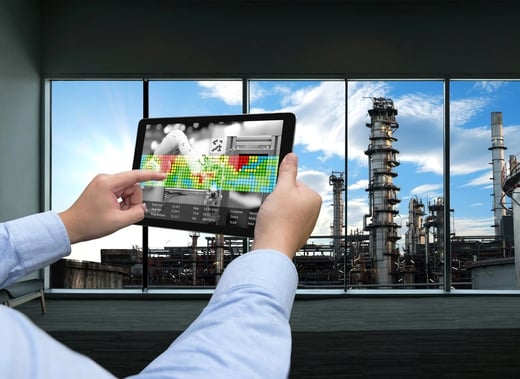
Unleashing the benefits of energy harvesting from electrical supplies
February 2022
By Paul Bearpark, Head of Electronics and Software at 42T
What do an electricity substation, an electromechanical switch and power tools have in common?
They can now all be remotely monitored by harvesting power from their existing electrical supply. Also, you can measure energy efficiency to find out if energy saving could be employed or equipment replaced.

Making the world smarter and more connected is a valuable ambition. It allows companies to optimise their operational efficiency and consumers to maximise convenience. The overall benefit is optimal asset monitoring and better control over assets leading to enhanced services, higher efficiency and less waste.
Making electrical devices smarter will often be straightforward because the existing electrical supply can be utilised to provide a permanent supply to the monitoring, control and communications electronics. While the benefits are clear and the vision tangible, there are practical difficulties to making it a reality.
One of these challenges is often to provide a source of power. Even at the low levels required for sensing and occasional low-power communications. In many circumstances, access to the mains or primary power supply might not be available or may be impractical, even for an electrical system. This is particularly the case when considering retrofit. Batteries could be employed but they have many major disadvantages – limited life, transportation difficulties (especially Lithium), disposal and safety issues.
However, at 42T we’ve found that remote monitoring and/or control capability is usually still possible where direct access to the mains or primary power is not available, and avoiding using a battery.
Let’s take a look at three examples.
1. Electricity substation monitoring
Most electricity substations have a very crude form of monitoring. The only device usually available is a ‘maximum demand indicator.’ This records the peak current flow in each phase since it was last reset. It’s an electromechanical device requiring an on-site visit to read and reset.
With the transition to electric vehicles, electric heating and renewable installations, electricity networks are becoming increasingly complex. Without understanding network demand patterns, Distribution Network Operators may be forced to make unnecessary upgrades or make them too late.
Providing power to a retrofitted monitoring system requires strict safety precautions, often involving disrupting the supply to consumers. With careful design of the electronics such that the power consumption is low, a retrofittable monitoring and communications system can be developed that harvests power from the electrical field generated by the current flowing in the supply.
Speak to an energy consultant
At 42T, we have developed a concept for a low-cost, non-contact system which is installed on each phase of the supplies without needing to disrupt them. It provides continuous measurement of voltage and current which can be communicated over a low power radio network such as NB-IoT.
It is continually powered whilst there is current flow and easily fitted without interrupting the supply. If monitoring is required during periods when there is little or no current flow, charge stored in a supercapacitor can provide a bridge.
This technique could be applied to any single or multi-phase electricity supply where there is sufficient electric field to power the electronics and the phases are individually accessible.
Figure 1 below provides a schematic of the system employed on each phase of the electricity supply. The device is attached to the cable or ‘bus bar’ providing the supply.
The attached device contains all the energy harvesting, sensing and communications electronics required to measure the electricity supply and occasionally communicate some data. In a multiphase system, the devices can be connected together to generate ‘pseudo-neutral’, making it possible to measure voltage in addition to current.
 Figure 1: non-contact electricity supply monitoring device
Figure 1: non-contact electricity supply monitoring device
2. Smart electromechanical switches
Electromechanical switches for powered devices are often the primary mechanism for switching them on and off. However, there are many occasions when it would be beneficial to switch them on or off remotely. This could be to replace the electromechanical switch where remote control operation is needed or in addition to the electromechanical switch itself.
Often there is a simple way to achieve this capability by leaking a small amount of current through the circuit to power the electronics when the main device is off. The power needed is a few tens of milliwatts or less. And leaking such a small amount of current through a device will not turn it on or result in any undesirable behaviour. It’s only when the device is switched on fully, that it operates as normal.
At 42T we have investigated this current leakage-scavenging method of powering circuits for remote control for several applications. It’s not suitable in every instance but often worthy of investigation because it can result in a simple, often retrofittable, device upgrade. All this without requiring a separate supply to the mains or a battery.
Remote control is one application, but the technique of current leakage-scavenging could be employed to monitor a piece of electrical equipment by replacing the electromechanical switch with a smart electromechanical switch. For instance, the smart switch could report how often and how long the device is used for, or its energy usage. With energy costs rising, it can be useful to have a measure of energy usage of a piece of electrical equipment to determine whether there are energy saving measures that could be employed or the equipment replaced by something more efficient.
3. Monitoring electrical devices when switched off
The third example of a novel method for making devices smarter is to do so even when they are switched off. Power tools could benefit from this; it would often be useful to know where a tool is or whether it has been dropped or mishandled during transport. One solution would be to provide a battery to power the electronics that monitors its state and communicates that state occasionally even when it’s off. However, as previously mentioned there are lot of downsides to adding a battery to a product.
An alternative is to use a super-capacitor. Super-capacitors do discharge over time but it is possible to design circuits that provide back-up power for a few hundred hours. The energy density is lower than a battery so the art is in designing the system to utilise the available charge carefully. For instance, the communications technology used needs to be suitable for a low energy supply. BLE (Bluetooth Low Energy) or NB-IoT could both be considered for this type of application. BLE requires that it is in range of a gateway device such as a mobile phone whereas NB-IoT is a cellular technology for very low power devices.
Enabling energy harvesting in the ways described requires two aspects to be considered and balanced. The power consumption of the system and the availability of harvestable power. Often, the available harvestable power is small if it relies on scavenging from the electromagnetic field, leaking current through the primary device or relying on the charge stored in a supercapacitor. The available energy then determines the requirement for very low-power system design.
Power to the people
Unleashing the power of connected everything should not be limited by the local availability of abundant, easily accessible energy. Often some lateral thinking about the energy sources that could be tapped into and the technology to do that, combined with up-front design and engineering of the bespoke sensing and communications system can enable the value of the measurement and control to be realised.
Free energy thereby becomes the key to power freedom.

If you would like to find out more please contact Paul:
paul.bearpark@42T.com | +44 (0)1480 302700 | www.linkedin.com/in/paul-bearpark
Paul Bearpark is an experienced engineer, engineering manager, product manager and energy consultant. He has spent over 25 years working in the field of electronics in both product development companies and technology consultancies.
During his career he has led the development of products through their entire life-cycle from concept to volume manufacture with ongoing support and upgrade.
He specialises in radio communications, sensor systems and systems engineering. He has worked in the defence and security, telecommunications, and test and measurement industries.
Share this article:
Related Articles

Connectedness, Industrial
How embedded edge devices can unlock machine learning for industry

Connectedness, Sustainability
Green claims - how recent EU regulations can help futureproof products and improve profitability

Connectedness
'A deep dive on connectivity' our article in New Electronics

What will you ask us today?
We believe in asking the right questions to drive innovation; when we know the right questions, we generate the ideas to answer them.

